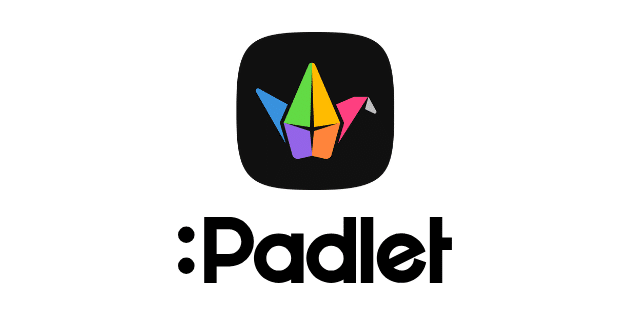
by California Casualty | Educators |
For many of us, Padlet* has become one of the “go-to” resources for virtual learning. This online bulletin board is an easy way to engage students, encourage collaboration, and inspire meaningful learning. If you haven’t yet used this digital tool, check out our “Don’t Know Padlet?” section below. If you’re a Padlet “pro,” jump right into the tips and tricks to take your virtual classroom to the next level.
Don’t know Padlet?
Padlet is an online space where you can post content for your students, and where they can post content for you and their classmates. Content can include text, audio, video, documents, spreadsheets, and more. Padlet is easy to use, even for young students, and it works on computers, laptops, Chromebooks, iPads, and smartphones. The free version allows you to create up to three Padlet boards at a time. A paid account is currently $8 a month for individuals; there’s bulk pricing for schools. Best of all, you don’t have to reinvent the wheel. You can copy other teachers’ Padlet pages to your account.
Default settings you may want to adjust
-
- The default setting is for post attribution to be turned off. In most cases, you want to know who posted. Turn on post attribution so you can see student names. Students need to sign in to create free Padlet accounts so their names will be included.
- Turn on the comments. This allows students to communicate with each other. But turn off the reactions. While it might be nice to get likes and stars, students could get competitive.
- Require approval before something gets posted. Enough said.
- Change the privacy setting to secret. Private means only you can see it. Secret allows anyone linked to the Padlet to view it.
“Pro” Tips and Tricks
Following are some proven ways that educators are using Padlet to teach everything from core subjects to the skills that will help students become better at gathering, reviewing, and analyzing information.
1. Graphic organizers
Displaying information so that it’s easy to access is a strength of Padlet. Make an interactive map with your students to explore parts of the world. Incorporate images, video, and music. Create a timeline for history class, literature study, or current events. You also can upload some of your favorite backgrounds to Padlet and display Venn diagrams and KWL charts where students may collaborate.
2. Live question bank
Whether you’re teaching virtually or also teaching in the classroom, you can open up a Padlet wall to take questions during the lesson. You can either answer the questions as they are posted, or take a break in the middle or near the end of the lesson to respond.
3. Class podcast
Turn your next unit topic into a class podcast on Padlet. Not only will students need to research and learn about the topic, but they will also need to present it. The entire unit can be organized on Padlet with subtopics, photos, video, and text. Everyone will cover the full topic but the final product will be an oral presentation where each student covers one aspect—so that the total presentation is a podcast.
4. Class debate
Pose a question and ask students to take sides—or assign them one. Their job is to gather content to support their side. Encourage dialogue and model how to have respectful conversations online about topics where they may disagree.
5. Book group
For classes reading the same book or story, Padlet offers a wonderful way to unpack the setting, characters, and plot. Have students post photos that depict the setting with text describing it. Discuss character and plot development via timelines, and invite students to submit drawings or GIFs to make it more exciting for them. Ask students to write book reviews as a cumulative activity.
6. Note-taking
Note-taking is an important skill that will help students as they continue their educational journey. Model how to take notes on Padlet by taping your own video tutorial that students may watch. Allow students to work together to add notes to a Padlet wall from a lesson that you teach. Review and color code the content that could appear on a quiz.
7. Beginnings and endings
Use Padlet as a bellringer activity as students enter the classroom. What do they remember from yesterday’s lesson? Ask them to respond to an image or quote. You also could use this type of quick response as an Exit Ticket. 3…2…1: What are 3 things you learned in the lesson? What are 2 questions you would put on a quiz? Answer one of those 2 questions.
8. Help needed
You can use Padlet to see who needs help during independent work. Set up a Padlet wall specifically for students to ask for help. Set it to the linear feature so you can easily see who is listed and in what order. Not only can students add their names to the list but they can see how many are ahead of them. Padlet also can be used to troubleshoot something that is not working online for a student. Ask him or her to upload a screenshot via Padlet and you can guide the student appropriately.
Do you have another way to use Padlet in the classroom? Share your ideas with fellow educators in the comments!
*Disclaimer: California Casualty is not in affiliation with and does not own any rights to Padlet. For more information on Padlet please visit their website at www.padlet.com
This article is furnished by California Casualty, providing auto and home insurance to educators, law enforcement officers, firefighters, and nurses. Get a quote at 1.866.704.8614 or www.calcas.com.

by California Casualty | Homeowners Insurance Info |
You found the perfect place to rent, and you’re ready to go. Moving company, check. Boxes and bubble wrap, check. Renter’s insurance?
If you’re wondering whether you need to purchase renter’s insurance, here are the most frequently asked questions.
What does renter’s insurance cover?
Renter’s insurance is like homeowner’s insurance but for tenants. As a start, it protects your personal belongings (that’s right, your landlord’s insurance policy will not cover your belongings) but that’s not all. It’s an important safeguard if you’re found at fault for property damage or injuries at your place (and even around the world). It also can help if you don’t have access to your apartment or home due to a covered loss.
Renter’s insurance policies offer (1) personal property coverage, (2) liability insurance, and (3) additional living expenses when your apartment or home is uninhabitable.
What is personal property coverage?
Personal property coverage protects your possessions. If they are stolen, or damaged by fire/smoke or other covered “perils,” your policy will pay for them. You’ll simply have to cover the smaller upfront fee known as the deductible.
You may choose the replacement cost or the actual cash value (ACV) for reimbursement. ACV is the amount the item is worth, minus depreciation for its age. It will cost a little more for a policy that provides replacement cost since that is higher than ACV.
With personal property coverage, you choose the amount of coverage based on how much your stuff is worth. The good thing is that your possessions are insured whether they’re at your place or away from it. For example, if you have a child away at college, who has an item stolen, your policy will pay 10% of your Personal Property Coverage C limit.
Note: Some policies limit certain types of possessions, such as jewelry. If you want a higher limit, you will need to add it to the policy.
What is liability coverage?
Liability coverage protects you if someone is injured and you’re legally liable. It could be at your place or it could be anywhere in the world. For example, if your dog bites someone, you’re covered. The policy pays for the bite victim’s medical expenses and covers court fees if they sue you. Liability also covers accidental damages to the place by you or your guests. So, if you accidentally set fire to your apartment, you’re covered. There are limits, so talk to your insurance advisor about an umbrella policy, which will provide much greater coverage.
What is loss of use coverage?
If a covered danger, like a fire or an evacuation, causes your residence to be unfit to live, your policy reimburses you for additional living expenses. For example, if you normally spend $200 per month on food and now it’s costing you $300, the policy will reimburse the additional $100. There’s a time limit and a dollar limit on this, so check on your policy’s details. Payment will be for the shortest time required to repair or replace the damage or, if you permanently relocate, the shortest time required for your household to settle elsewhere. It’s worth noting that if you have a Coverage Enhancement, there’s no deductible.
What exactly is the deductible?
If a loss does occur, a deductible will often apply. A deductible is the amount that you are responsible for, before the policy pays anything. So, before you get replacement or ACV for your possessions, you pay the deductible out of your pocket. Your deductible could be $250, $500, or more. You have a choice on the amount of the deductible. The lower the deductible, the more expensive the policy.
Note: There are times when there is no deductible. In a personal liability policy, for example, a deductible does not apply.
What isn’t covered by renter’s insurance?
Renter’s insurance doesn’t cover every situation. It does not cover damage from earthquakes, mudslides or floods. It does not cover infestations of rodents or bugs. There’s only limited coverage for theft of jewelry and firearms. A standard policy doesn’t cover your roommate’s possessions (though you could add them as an endorsement known as “Other Members of Your Household” for little or no cost). Renter’s insurance also doesn’t consider your car as one of your possessions. You need a separate auto insurance policy.
Note: Ask your insurer about home office and business computer coverage. That’s different than a personal policy.
Is renter’s insurance required?
Renter’s insurance is not mandated by law, but it may be required by your landlord, property manager or owner. Renter’s insurance helps keep others, including you, from seeking damages from them, even though they’re not responsible for your possessions. If you accidentally start a fire, the landlord’s insurance kicks in after they pay the deductible. But they could use your renter’s policy to cover that cost, so it’s a win-win for them.
What happens if you don’t have renter’s insurance?
If you don’t have renter’s insurance, you’re fully responsible for any property damage or loss. You’ll have to replace your possessions in the event of theft, fire, or other perils. You’ll have to pay the medical costs of anyone injured in your apartment. You’ll have to pay for additional living expenses if your apartment is inhabitable.
How expensive is renter’s insurance?
Renter’s insurance is surprisingly affordable. For as little as $10 a month, you can get a renter’s policy at California Casualty. The cost varies depending upon the coverages you choose, the deductible, your financial responsibility score, and multipolicy discount. Even your location can have an impact. Areas with higher crime rates will have higher insurance rates.
How much renter’s insurance do you need?
You want to have enough insurance to cover your possessions and any potential liability. Start by taking an inventory of what you own and putting a dollar figure on replacing our possessions. Then, take a look at your liability. Do you entertain a lot? Do you have pets? Determine the potential for injuries on site or any other property damage. You also want to take into consideration the amount of assets you have – such as your savings, etc. You want to make sure the amount you select will cover your assets. Then, choose the deductible that is affordable for you.
Can you get renter’s insurance after you’re already moved in?
Yes. You may purchase renter’s insurance at any time. However, it’s not retroactive. You cannot buy it after there’s been damage or theft.
Not all renter’s insurance is the same. Some policies cover more than others and costs vary. Check with your insurance provider to find out the options.
This article is furnished by California Casualty, providing auto and home insurance to educators, law enforcement officers, firefighters, and nurses. Get a quote at 1.866.704.8614 or www.calcas.com.
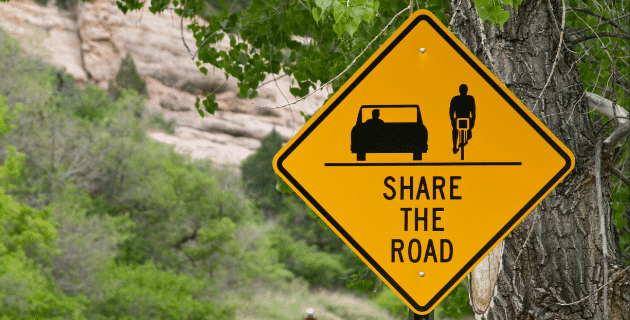
by California Casualty | Auto Insurance Info |
When it comes to sharing the road with others, let’s face it, we don’t always know what (or whatnot) to do. Ask anyone who has ever been behind a slow-moving vehicle or who has tried to pass an 18-wheeler…
Here’s a quick guide on the rules of the road as they pertain to sharing it with trucks, buses, motorcycles, bicycles, slow-moving vehicles, and pedestrians—plus a final word on the importance of moving over for emergency vehicles.

Trucks
A big rig weighs considerably more than the average car, and could be as much as 20-30 times heavier, according to the Federal Motor Carrier Safety Administration. Their significant size and weight affect how quickly they can stop, go, and maneuver with lane changes and turns. Despite mirrors and a bird’s eye view, trucks also have large blind spots. And if your car is in one, the trucker likely has no idea you’re there.
-
- Don’t cut off a truck by driving into the empty space just in front of them. While it takes a normal passenger car traveling at 65 mph about 300 feet to stop, it takes double that distance for a fully loaded commercial truck at the same speed. If you’re too close, the truck may not be able to slow down and avoid a collision.
- Do not try to get past a truck to reach an exit or turn. Slow down and stay behind.
- Know the locations of a truck’s blind spots and avoid them. These are typically directly in front, directly behind, and along the sides, but especially the right side. The general rule is that if you cannot see the truck driver’s reflection in his or her side mirror, most likely he can’t see you.
- The longer the vehicle, the greater the turning path will be. Big rig drivers often swing wide to make a turn. That means swinging left just before turning right. Watch the trucker’s turn signals and expect the driver to swing the other way. Importantly, do not pass a truck while turning or you might find yourself in its path.
- Always pass a truck on the left side. Once you pass, do not linger. Move out ahead so the truck knows you are there.
- Do not tailgate. You may not have enough time to stop if the truck in front of you stops quickly.

Buses
Buses face many of the same stopping and maneuverability issues that trucks do. The driver has the added pressure of being responsible for a busload of people—and sometimes children. With constant stops, and people getting on and off, there’s even more to consider when driving near a bus.
-
- School buses have warning lights. A flashing yellow means slow down; a flashing red means stop. Stop no matter where your vehicle is, including if it is alongside the bus.
- Remember that it is illegal to pass a school bus that has stopped to pick up or drop off children.
- Expect that public buses also will stop frequently. Maintain a safe distance behind them.
- Large vehicles like buses have a higher center of gravity and must travel more slowly around curves and on-ramps. If you’re behind them, adjust your speed. Do not cut them off.
- Remember that buses have large blind spots too, similar to trucks. They are usually immediately behind the side flat mirrors and behind the rear bumper. Try to stay visible and avoid those areas.

Motorcycles
Motorcycles are smaller than cars and significantly smaller than trucks and buses. So, it’s easy to see how they could almost “disappear” in your blind spots. Motorcycles can come up quickly without you realizing they’re there. That’s why it’s always good to be extra observant and know every vehicle sharing the road with you.
-
- Do a visual check and use your mirrors when you change lanes, enter a major road or make a turn.
- Allow motorcycles to have the width of the full lane width when possible.
- Never try to pass a motorcycle that is sharing the same lane as you. Move to one side to give them the room to pass.
- Road conditions can cause motorcycles to change speed or direction suddenly. These include wet slippery surfaces, gravel, and potholes. Anticipate this and be ready to adjust your speed and lane accordingly.
- When you park your car, look for motorcycles before opening your car door.
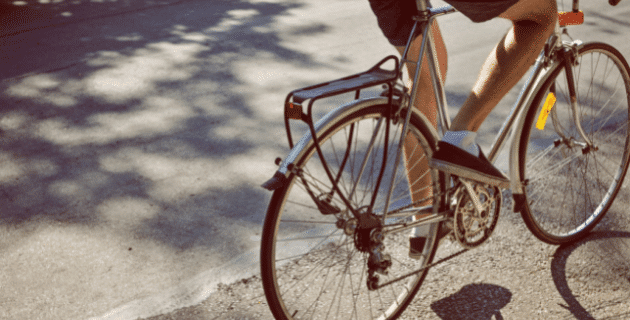
Bicycles
Bicycles have the right to be on the road with other vehicles, providing that they are following the rules. This includes proper lighting and reflectors at night, riding in the direction of traffic, signaling when changing lanes, and staying as near to the right curb as possible. In some cases, bicyclists may have a dedicated bike lane.
-
- Be aware that bicyclists may be permitted to ride on certain sections of highways where there is no alternate route and where bicycling is not prohibited by a sign.
- As with cars, bikes are required to signal turns. A left turn is the left arm extended to the side. A right turn is the left arm bent at a 90-degree angle with the hand at the top. The stop signal is the same with the hand at the bottom. Learn the hand signals so you know what the cyclist is communicating.
- Remember that your car weighs about 20 tons and a bike can weigh 20 lbs. or even less. Your car can do severe damage to a bicyclist and bike.
- Some states have laws about the amount of space you must give bicyclists. The general rule is to give them about 3 feet of clearance.
- After you park, look before you open your car door. There might be a bike coming.
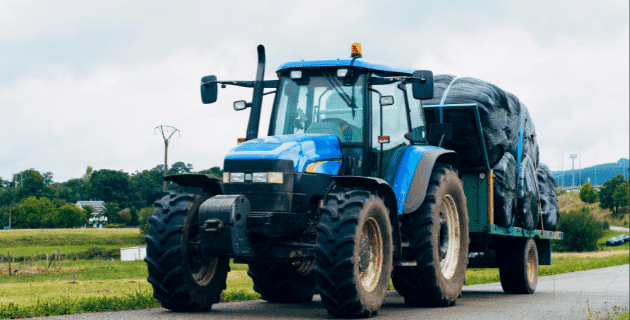
Slow-Moving Vehicles
It can be frustrating to be stuck behind farm tractors, animal-drawn carts, or road maintenance trucks. These slow-moving vehicles typically will display a reflective orange triangle so you are aware of their speed as you approach them.
-
- Slow down. Reduce your speed before you reach the slow-moving vehicle.
- Don’t sound your horn. You could scare a horse, and sounding a horn will not help a slow-moving vehicle move any faster.
- Be aware that animal-powered vehicles could make sudden movements.
- If there is enough room to pass them, do so carefully on the left.
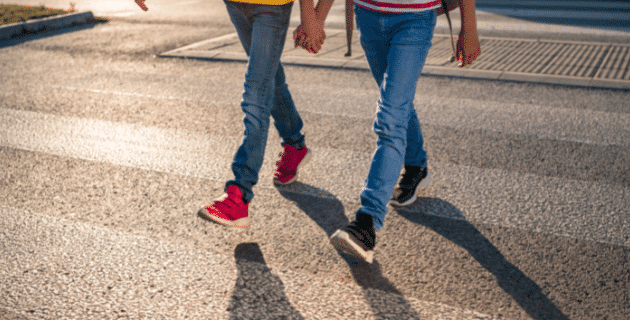
Pedestrians
Vehicles commonly share the road with pedestrians when they are crossing the street. Typically, this would be at a crosswalk. Check your local laws. In some cases, pedestrians do not always have the right of way. However, drivers do have a responsibility to be aware of people walking so they do not hit them.
-
- Stop at all crosswalks where pedestrians are waiting.
- Make sure your car is within 5 feet of the crosswalk. This helps blind pedestrians sense the presence of your vehicle.
- Do not turn before looking for pedestrians.
- Use extra caution in low visibility situations such as dusk, nighttime, or in bad weather. There may be a pedestrian whom you do not see.
- Never pass vehicles stopped at a crosswalk. They could be stopping for someone.
- Leave room. Consider a vehicle emergency braking with pedestrian and cyclist detection.
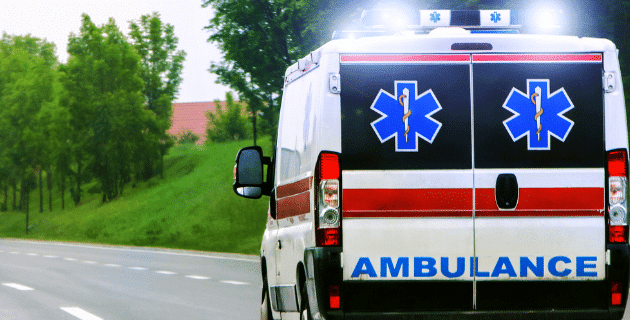
Emergency Vehicles
Police cars, fire engines, and ambulances need to get to the places where they can provide help to people in need. When you see flashing lights or hear sirens, that’s your cue to pull over to the side of the road. You can help emergency vehicles by giving them a clear path to their destination.
Following these rules for sharing the road will help keep you safe. Having the right auto insurance policy will provide peace of mind should you need that coverage. Safe travels.
This article is furnished by California Casualty, providing auto and home insurance to educators, law enforcement officers, firefighters, and nurses. Get a quote at 1.866.704.8614 or www.calcas.com

by California Casualty | Homeowners Insurance Info |
You have a roof over your head, but chances are you’re probably not thinking too much about it. That’s because—unless your roof needs repair or replacement— there really is no reason to worry about it.
The best way to know if your roof needs to be repaired or replaced is to hire a professional to come out and take a look. We’ve compiled a quick guide on roofs and roof damage, including what to look for, so you’ll be well informed when it comes time to repair or get a new roof.
Types of Roofs
Roofs are made from different kinds of material. Some of the most common include:
-
- Asphalt: This is the most affordable roofing material (and likely what is on your house). Asphalt shingles come in basic and also higher-end versions.
- Slate: One of the most expensive roofs you can buy, its shingles are made from slate tiles. They are very heavy, requiring a roof system that can bear their weight.
- Composite: These types of shingles are made from rubber, plastic and other recycled materials. They can be made to look like a cedar shake or slate roof.
- Metal: A standing seam metal roof consists of metal panels that are locked together.
There are other types of roofing materials from concrete to clay shingles and beyond, including green roofs which use gardens to top a house. Knowing the type of roof on your house is the first step to being able to repair or replace it.
Types of Roof Damage
Punctures and cracks, loose and broken shingles, damage from moisture, and worn-out roofing materials must be addressed or your roof could fail to do its job. Here’s what you might expect due to weather and over time.
-
- Water damage: Moisture gets into the cracks and crevices, and causes mildew, mold, moss, and decay.
- Hail damage: Large pieces of hail can make dents in your shingles and destroy the roof’s metal finishes. It can lead to roof leaks.
- Snow and ice damage: Heavy snow and ice can put stress on your roof, potentially causing its collapse. It also puts wear and tear on your shingles.
- Wind damage: Strong winds can rip off shingles and cause debris to hit your roof and damage it.
- Tree or branch damage: When a tree falls on your home or if you fail to keep your branches trimmed, they can put a hole in your roof, requiring immediate action.
How to Check Your Roof for Damage
It’s a good idea to check your roof for damage after a storm or other weather event, and you don’t have to get up on the roof to do it. (Leave on-the-roof exploration to the professionals, unless you are experienced at it.)
Start with a pair of binoculars on ground level. Point them toward your roof and look for obvious damage.
-
- Check for debris that may still be on your roof or clogging your gutters.
- See if there are damaged, cracked, or missing shingles. Get an approximate count and note their location.
- With asphalt roofs, look for curled edges, bubbling or blistering.
- Check for smooth dark areas that could indicate mold.
- Check for signs of moss.
- Look for signs of sagging.
- See if your gutters or downspouts have loosened or broken.
- Check the flashing, which is aluminum or steel used to cover joints in the roof, to see if it is damaged or loose.
- If you do go up on your roof, check for a bounce when you walk across it. That happens if a roof is spongy from moisture.
If you have an attic, you can assess roof damage there as well.
-
- Look for water stains that run from the ceiling to the walls.
- Check for leaks.
- Look for gaps or cracks in seals on skylights, chimney, and vents (most easily seen when lights are off in the attic and it’s a sunny day).
- Check for any signs of animal life that could indicate a hole.
- Look for shiners (nails sticking out on the underside of the roof). They’re easier to spot on a cold night. Moisture condenses on these nails, turning them white with frost.
If you don’t have an attic, you can still check for leaks and water stains on the ceiling, and along any walls or skylights. Wherever you find damage, take a picture if you can, as a reference for contractor repairs or your insurance company.
Repair or Replace
On the outside– Damaged shingles are roof leaks waiting to happen. Clogged gutters are the precursor to water damage. These instances put your roof at risk for future problems. Routine maintenance and frequent checking of your roof should help you identify these risks before they become a problem.
On the inside– You may only be aware of some of the damage through your on-the-ground and in-attic check. If you believe there is significant damage, consult a professional roof inspector. They can use hi-tech equipment including infrared sensors and drones to examine your roof.
Make sure you are protected by speaking to your home insurance provider. They will be able to review your policy with you and make sure you have the proper roof coverage that you need.
This article is furnished by California Casualty, providing auto and home insurance to educators, law enforcement officers, firefighters, and nurses. Get a quote at 1.866.704.8614 or www.calcas.com

by California Casualty | Auto Insurance Info |
As parents, we do more than just drive our kids around. Our cars are on-the-go eateries, curbside retreats, entertainment stations, and sometimes even offices. Finding the perfect vehicle that fits all of the needs of your family is so important.
That’s why we’ve tracked down this year’s most popular cars for moms and dads. Check them out, all listed here in alphabetical order.
2022 Ford Expedition (Large SUV)
Starting at $51,000
If you can afford the price tag, the Ford Expedition is highly ranked by Edmunds for its space and power. You can fit up to 8 with ample room for your gear. With the premium package, you get a massive 15.5-inch high-definition touch display and the option for massaging front seats! The rear-seat entertainment systems let kids stream videos and play games on Amazon Fire TV.
There also are power-folding running boards which serve as a step-stool for kids.
2022 Honda Odyssey (Minivan)
Starting at $33,040
The Odyssey has been the top pick in past years for Kelley Blue Book’s “Minivan Best Buy” and a top safety pick for 2021-22 by the Insurance Institute for Highway Safety. It seats up to 8, including 5 car seats. The third row splits and folds with plenty of room for a stroller. The Cabin Watch feature lets you keep tabs on the kids in the back and a Cabin Talk option lets you chat with passengers through the speakers, including through DVD headphones. There’s a wireless charging pad in the front seat and front and rear USB ports. (Unfortunately, the popular vacuum cleaner is no longer included, as that company went out of business during the pandemic.)
2022 Hyundai Palisade (Midsize SUV)
Starting at $34,375
The Hyundai Palisade was a top safety pick in 2021 by the Insurance Institute for Highway Safety. It’s also one of Car and Driver’s favorite three-row family SUVs. There’s room for up to 8 passengers, and the second seat has a one-touch button that moves it forward to easily get to the back row. There are up to 7 USB ports and the ability to connect two Bluetooth devices at the same time. There’s also a touchscreen infotainment display. With seats folded down, there’s plenty of cargo room. Testers fit 33 carry-on suitcases!
2022 Kia Carnival (Minivan)
Starting at $33,555
The Kia Carnival is a minivan that looks like an SUV. They call it an MPV—multi-purpose vehicle. It seats up to 8 with plenty of legroom. Parents will love the optional in-cabin camera system with a zoom function and night vision that allows you to keep an eye on the backseat day or night. A VIP lounge option offers second-row captain’s chairs with kick-out leg rests. The third row can fold flat to the floor for extra storage. The vehicle’s Safe Exit Assist warns passengers not to exit if it’s unsafe. The car also texts you if movement is detected in your car 24 hours after you’ve exited, in case you’ve forgotten a child or a pet in the car.
2022 Kia Telluride (SUV)
Starting at $34,345
The Kia Telluride ranks in Car and Driver’s Top 10 Best Cars and Trucks for 2022 for its combination of comfort, safety, and affordability. It has luxury features like a 12-way power driver’s seat, a 10.3-inch touchscreen, and robust infotainment system, and heated and ventilated rear seats. Yet it will tug a 5,000-pound trailer with ease. Its quiet mode shuts off rear speakers and lowers the volume in front for nappers. There’s room for 8 unless you choose the option for second-row captain’s chairs, and then you’ve got 7.
2022 Subaru Forester (Small SUV)
Starting at $26,320
With safety and driver-assist features as standard, it’s no wonder that the Forester was a top safety pick for 2021 by the Insurance Institute for Highway Safety. There’s roomy seating for 5, and the Forester scores well on fuel economy (26 mpg city, 33 mpg highway). There’s a touchscreen infotainment system and up to four USB ports, including two for the backseat passengers.
2022 Toyota Highlander (Midsize SUV)
Starting at $36,420
Available as a hybrid, this popular family vehicle is a top safety pick for 2021-22 by the Insurance Institute for Highway Safety. It seats 8, with options for heated seats in the front and second rows. Infotainment and driver assistance features come standard. Choose a higher trim level and you’ll get a 12.3-inch display. Fuel economy is good, with up to 29 mpg on the highway with front-wheel drive.
2022 Toyota Sienna (Hybrid Minivan)
Starting at $36,000
Kelley Blue Book named the Toyota Sienna the best buy of 2022. As a hybrid, it delivers fuel economy – 36 mpg on the highway. It also is a top safety pick for 2021-22 by the Insurance Institute for Highway Safety. Three rows of seats are fully equipped with headphone jacks, charge ports, and the ability to recline back. Stow the third row for extra cargo space. The 9-inch infotainment system and a Wi-Fi hot spot makes it easy to connect.
2022 Volvo XC90 (Midsize SUV)
Starting at $51,995
Volvo is known for safety so it’s no surprise that the XC90 is a top safety pick for 2021-22 by the Insurance Institute for Highway Safety. If you can get past the price tag, it also has some nice features. Navigation is standard. You can choose a Climate Control package with a heated steering wheel and heated rear seats. The third row is not roomy enough for adults but works for kids. You can get this vehicle as a plug-in hybrid too.
2022 Volkswagen Atlas (SUV)
Starting at $35,095
With its large cargo capacity and comfortable three-row seating, the Atlas is made for family transport. Families will enjoy the multiple storage nooks and plenty of cupholders, as well as USB ports, including in the back seat. Testers fit an impressive 38 carry-on suitcases with the seats folded down, and four could fit behind the third row with the seats up.
Of course, you don’t have to buy a brand-new car. There are a lot of good options for used cars, too. Whatever you drive, make sure to protect your car with the right auto insurance.
For parents of teens, you can also check out the most popular vehicles for teenagers here!
This article is furnished by California Casualty, providing auto and home insurance to educators, law enforcement officers, firefighters, and nurses. Get a quote at 1.866.704.8614 or www.calcas.com.












